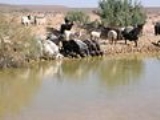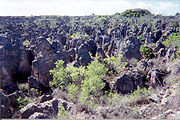
Land degradation
Encyclopedia

It is viewed as any change or disturbance to the land perceived to be deleterious or undesirable. Natural hazard
Natural hazard
A natural hazard is a threat of a naturally occurring event that will have a negative effect on people or the environment. Many natural hazards are interrelated, e.g. earthquakes can cause tsunamis and drought can lead directly to famine. It is possible that some natural hazards are...
s are excluded as a cause, however human activities can indirectly affect phenomena such as floods and bushfires.
It is estimated that up to 40% of the world's agricultural land is seriously degraded.
Causes

Agriculture
Agriculture is the cultivation of animals, plants, fungi and other life forms for food, fiber, and other products used to sustain life. Agriculture was the key implement in the rise of sedentary human civilization, whereby farming of domesticated species created food surpluses that nurtured the...
use. The major causes include:
- Land clearance, such as clearcuttingClearcuttingClearcutting, or clearfelling, is a controversial forestry/logging practice in which most or all trees in an area are uniformly cut down. Clearcutting, along with shelterwood and seed tree harvests, is used by foresters to create certain types of forest ecosystems and to promote select species that...
and deforestationDeforestationDeforestation is the removal of a forest or stand of trees where the land is thereafter converted to a nonforest use. Examples of deforestation include conversion of forestland to farms, ranches, or urban use.... - Agricultural depletion of soil nutrientNutrientA nutrient is a chemical that an organism needs to live and grow or a substance used in an organism's metabolism which must be taken in from its environment. They are used to build and repair tissues, regulate body processes and are converted to and used as energy...
s through poor farming practices - LivestockLivestockLivestock refers to one or more domesticated animals raised in an agricultural setting to produce commodities such as food, fiber and labor. The term "livestock" as used in this article does not include poultry or farmed fish; however the inclusion of these, especially poultry, within the meaning...
including overgrazingOvergrazingOvergrazing occurs when plants are exposed to intensive grazing for extended periods of time, or without sufficient recovery periods. It can be caused by either livestock in poorly managed agricultural applications, or by overpopulations of native or non-native wild animals.Overgrazing reduces the... - Inappropriate IrrigationIrrigationIrrigation may be defined as the science of artificial application of water to the land or soil. It is used to assist in the growing of agricultural crops, maintenance of landscapes, and revegetation of disturbed soils in dry areas and during periods of inadequate rainfall...
and overdraftingOverdraftingOverdrafting is the process of extracting groundwater beyond the safe yield or equilibrium yield of the aquifer.Since every groundwater basin recharges at a different rate depending upon precipitation, vegetative cover and soil conservation practises, the quantity of groundwater that can be safely... - Urban sprawlUrban sprawlUrban sprawl, also known as suburban sprawl, is a multifaceted concept, which includes the spreading outwards of a city and its suburbs to its outskirts to low-density and auto-dependent development on rural land, high segregation of uses Urban sprawl, also known as suburban sprawl, is a...
and commercial development - Land pollutionLand pollutionLand pollution is the degradation of Earth's land surfaces often caused by human activities and their misuse of land resources. It occurs when waste is not disposed properly. Health hazard disposal of urban and industrial wastes, exploitation of minerals, and improper use of soil by inadequate...
including industrial wasteIndustrial wasteIndustrial waste is a type of waste produced by industrial activity, such as that of factories, mills and mines. It has existed since the outset of the industrial revolution.... - Vehicle off-roadingOff-roadingOff-roading is a term for driving a vehicle on unsurfaced roads or tracks, made of materials such as sand, gravel, riverbeds, mud, snow, rocks, and other natural terrain.-Off-road vehicle:...
- QuarryQuarryA quarry is a type of open-pit mine from which rock or minerals are extracted. Quarries are generally used for extracting building materials, such as dimension stone, construction aggregate, riprap, sand, and gravel. They are often collocated with concrete and asphalt plants due to the requirement...
ing of stone, sand, ore and minerals
Effects

The major stresses on vulnerable land include:
- Accelerated soil erosion by wind and water
- Soil acidificationSoil acidificationSoil acidification is the buildup of hydrogen cations, also called protons, reducing the soil pH. This happens when a proton donor is added to the soil. The donor can be an acid, such as nitric acid and sulfuric acid . It can also be a compound such as aluminium sulfate, which reacts in the soil to...
and the formation of acid sulfate soilAcid sulfate soilAcid sulfate soils are naturally occurring soils, sediments or organic substrates that are formed under waterlogged conditions. These soils contain iron sulfide minerals or their oxidation products. In an undisturbed state below the water table, acid sulfate soils are benign...
resulting in barren soil - Soil alkalinisation owing to irrigation with water containing sodium bicarbonateSodium bicarbonateSodium bicarbonate or sodium hydrogen carbonate is the chemical compound with the formula Na HCO3. Sodium bicarbonate is a white solid that is crystalline but often appears as a fine powder. It has a slightly salty, alkaline taste resembling that of washing soda . The natural mineral form is...
leading to poor soil structureSoil structureSoil structure is determined by how individual soil granules clump or bind together and aggregate, and therefore, the arrangement of soil pores between them...
and reduced crop yields - Soil salinationSoil salinationSoil salinity is the salt content in the soil.- Causes of soil salinity :Salt-affected soils are caused by excess accumulation of salts, typically most pronounced at the soil surface. Salts can be transported to the soil surface by capillary transport from a salt laden water table and then...
in irrigated land requiring soil salinity control to reclaim the land - Soil waterloggingWaterlogging (agriculture)Waterlogging refers to the saturation of soil with water. Soil may be regarded as waterlogged when the water table of the groundwater is too high to conveniently permit an anticipated activity, like agriculture....
in irrigated land which calls for some form of subsurface land drainageDrainage system (Agriculture)An agricultural drainage system is a system by which the water level on or in the soil is controlled to enhance agricultural crop production.-Classification:Figure 1 classifies the various types of drainage systems...
to remediate the negative effects - Destruction of soil structureSoil structureSoil structure is determined by how individual soil granules clump or bind together and aggregate, and therefore, the arrangement of soil pores between them...
including loss of organic matterOrganic matterOrganic matter is matter that has come from a once-living organism; is capable of decay, or the product of decay; or is composed of organic compounds...
Overcutting of vegetation occurs when people cut forests, woodlands and shrublands—to obtain timber, fuelwood and other products—at a pace exceeding the rate of natural regrowth. This is frequent in semi-arid environments, where fuelwood shortages are often severe.
Overgrazing is the grazing of natural pastures at stocking intensities above the livestock carrying capacity; the resulting decrease in the vegetation cover is a leading cause of wind and water erosion. It is a significant factor in Afghanistan.
Agricultural activities that can cause land degradation include shifting cultivation
Shifting cultivation
Shifting cultivation is an agricultural system in which plots of land are cultivated temporarily, then abandoned. This system often involves clearing of a piece of land followed by several years of wood harvesting or farming, until the soil loses fertility...
without adequate fallow periods, absence of soil conservation measures, fertilizer use, and a host of possible problems arising from faulty planning or management of irrigation. They are a major factor in Sri Lanka and the dominant one in Bangladesh.
The role of population factors in land degradation processes obviously occurs in the context of the underlying causes. In the region, in fact, it is indeed one of the two along with land shortage, and land shortage itself ultimately is a consequence of continued population growth in the face of the finiteness of land resources. In the context of land shortage the growing population pressure, during 1980-1990, has led to decreases in the already small areas of agricultural land per person in six out of eight countries (14% for India and 22% for Pakistan).
Population pressure also operates through other mechanisms. Improper agricultural practices, for instance, occur only under constraints such as the saturation of good lands under population pressure which leads settlers to cultivate too shallow or too steep soils, plough fallow land before it has recovered its fertility, or attempt to obtain multiple crops by irrigating unsuitable soils.
Severe land degradation affects a significant portion of the Earth's arable lands, decreasing the wealth and economic development
Economic development
Economic development generally refers to the sustained, concerted actions of policymakers and communities that promote the standard of living and economic health of a specific area...
of nations. As the land resource base becomes less productive, food security
Food security
Food security refers to the availability of food and one's access to it. A household is considered food-secure when its occupants do not live in hunger or fear of starvation. According to the World Resources Institute, global per capita food production has been increasing substantially for the past...
is compromised and competition for dwindling resource
Resource
A resource is a source or supply from which benefit is produced, typically of limited availability.Resource may also refer to:* Resource , substances or objects required by a biological organism for normal maintenance, growth, and reproduction...
s increases, the seeds of famine
Famine
A famine is a widespread scarcity of food, caused by several factors including crop failure, overpopulation, or government policies. This phenomenon is usually accompanied or followed by regional malnutrition, starvation, epidemic, and increased mortality. Every continent in the world has...
and potential conflict are sewn.
Climate change
Significant land degradation from seawaterSeawater
Seawater is water from a sea or ocean. On average, seawater in the world's oceans has a salinity of about 3.5% . This means that every kilogram of seawater has approximately of dissolved salts . The average density of seawater at the ocean surface is 1.025 g/ml...
inundation, particularly in river delta
River delta
A delta is a landform that is formed at the mouth of a river where that river flows into an ocean, sea, estuary, lake, reservoir, flat arid area, or another river. Deltas are formed from the deposition of the sediment carried by the river as the flow leaves the mouth of the river...
s and on low-lying islands, is a potential hazard that was identified in a 2007 IPCC
Intergovernmental Panel on Climate Change
The Intergovernmental Panel on Climate Change is a scientific intergovernmental body which provides comprehensive assessments of current scientific, technical and socio-economic information worldwide about the risk of climate change caused by human activity, its potential environmental and...
report. As a result of sea-level rise from climate change, salinity levels can reach levels where agriculture becomes impossible in very low lying areas.
See also
Further reading
This article incorporates text in the public domain produced by the USDA Natural Resources Conservation Service- D.L. Johnson and L.A. Lewis Land Degradation:Creation and Destruction, 2nd edition, Rowman and Littlefield, Lanham, Boulder, New York, Toronto, Oxford, 2007.

